Canal tow-path exercise: ‘I can’t socially distance’
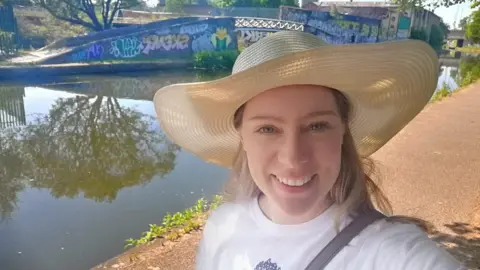 Ruth Millington
Ruth MillingtonThe number of people using canal tow-paths has increased by almost 200% in urban areas since lockdown began.
On a narrow tow-path, social distancing is difficult to achieve but for those with limited access to green spaces it is often one of their few options.
Some canal visitors in Birmingham said they were once an "escape" but edging past others filled them with anxiety.
The Canal and River Trust has urged people to limit their use of the waterways which remain open for all.

"Living in the city centre, canals have always been my escape," Ruth Millington, who lives in a studio flat in Birmingham's Jewellery Quarter, said.
She has no garden and relies on the city's extensive canal network for exercise and stress-relief. "It's so important for my mental health," she said.
With famously more canals than Venice, it is no surprise the waterways are significant to the people of Birmingham.

The Canal and River Trust reported that, since lockdown came into force on 23 March, the number of people using the canals in inner-city Birmingham had increased by 171% - from a daily average of 463 to 1,254.
For Ms Millington, the increase has meant her outdoor activity has had an adverse effect on her mental health instead of a positive one.
"I've found my usual walk along the canal stressful because the paths are so busy and this has added to my anxiety," she said.
"The narrow paths can't accommodate all of the cyclists, runners, dog walkers and groups of people walking together."
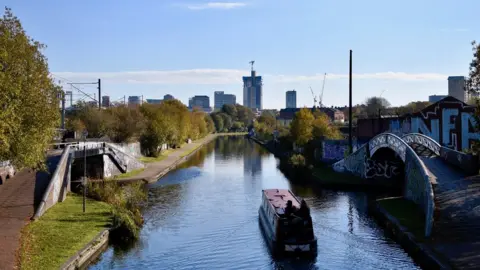
The Canal and River Trust charity reported a "shift in usage" from busy tourist hotspots in favour of less-used tow-paths in residential areas, "often amongst less affluent communities where green space is often at a premium".
Burnley, Sandwell and Blackburn have seen the greatest increase in visitors to the canal network, while the number of visitors to canals in tourist hotspots such as Camden, Paddington and Birmingham's Brindley Place has dropped by more than half.
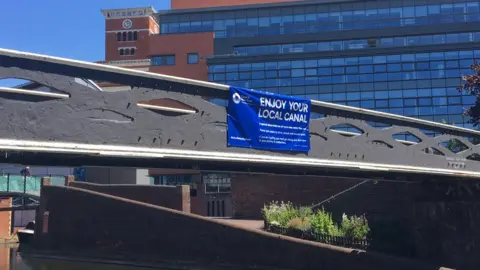
A growing body of research links parks and green spaces to wellbeing, although millions of people in the UK do not have access to parks or green spaces nearby.
"My mental health is really suffering from being inside," Ms Millington said, adding she was now having to balance the risk of not being able to social distance against the impact on her wellbeing.
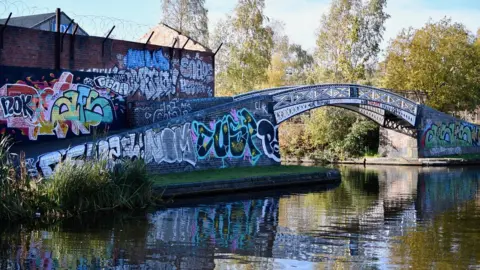
It is a balance the Canal and River Trust is deeply conscious of.
The charity put up signage across its network encouraging people to limit their use of tow-paths but said it was working to manage social distancing without cutting off access to green space from those least likely to have gardens or live near parks.
"Our canals provide, for many people, a vital green or blue route on-their-doorstep, but people must limit their use and act considerately at this time," the trust's chief executive Richard Parry said.
"Canals can be a lifeline for people, but only if we use them responsibly."
 Raj Sanghera
Raj SangheraRaj Sanghera has just bought a house which backs on to the Birmingham New Main Line canal.
He said the canal had become his main access route into town and, since lockdown, a place he took trips out.
"We've really embraced canal life."
He said he had noticed "a massive increase in people" using the tow-paths and so has had to change his habits to better maintain social distancing.
"It puts me off going at 'peak times'," the keen runner said. "I'm getting up earlier to go out to avoid people."
The number of visitors is exacerbated by the fact only one side of the canal is paved, he said, forcing the majority of people on to one side of the tow-path where they are further restricted by overgrown shrubbery.
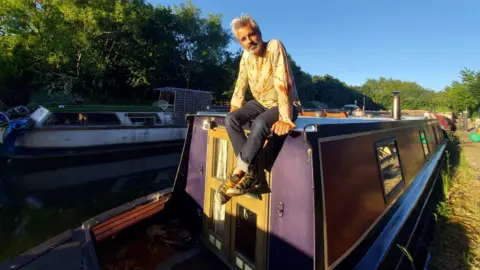 Tim Morley
Tim MorleyFor boater Tim Morley, the increase in people using tow-paths has been noticeable - on some days they have been akin to "a motorway", he said.
He lives with his partner on a boat in Hockley Port, a section of canal off Birmingham's Soho Loop near the Jewellery Quarter.
"We've been trying to exercise every day and the tow-path is the natural place to do it," he said.
But the network was "never designed for that volume of people," he said, and he has instead taken to walking around local industrial estates to avoid people using the tow-paths.
"My partner thinks I'm mad but I think they're fascinating," he said.
"We don't want to be near people but we also want to offer space to people who live in flats and only have access to the canals for a couple of hours a day."
Mr Morley, who works all over the world as an academic facilitator, has been living on a boat for three years.
Part of the advice issued by the Canal and River Trust was for pedestrians and cyclists to avoid areas where boats are moored to protect boaters.
"When you're moored, you're inches from the tow-path," Mr Morley said, but added Hockley Port was closed to members of the public, "so we don't really get people walking past us".
The Canal and River Trust said it wanted people to continue using the network, "to enjoy the benefits of spending time by water".
"We're just asking that they be responsible and considerate when doing so."

- SYMPTOMS: What are they and how to guard against them?
- FACE MASKS: When should you wear one?
- YOUR QUESTIONS: Our experts have answers
- LOOK-UP TOOL: How many cases in your area?
- SOCIAL DISTANCING: The rules as they are now

Follow BBC West Midlands on Facebook, Twitter and Instagram. Send your story ideas to: [email protected]
